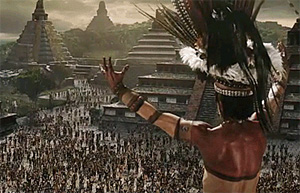 |
 |
 |
 Editorials | Opinions | February 2007 Editorials | Opinions | February 2007  
“Racist” Apocalypto Opens In Latin America
 Allan Wall - MexData.info Allan Wall - MexData.info


| | “Apocalypto”, a thriller dealing with the Mayan civilization, opened in Mexican theaters on January 25th. (Pirated DVDs, of course, had been available on the streets before that). |
Mel Gibson’s “Apocalypto” has been criticized for inaccuracies and for misrepresenting the Mayan culture. Ricardo Cajas, “Racism Commissioner” for the Guatemalan government, has blasted the movie as racist

To summarize the movie, without giving it away for those who haven’t seen it (I hate it when people do that!), “Apocalypto” deals with the downfall of the Mayan civilization. The protagonist is a Mayan hunter named “Jaguar Paw” portrayed by actor Rudy Youngblood. The movie was filmed in the state of Veracruz on the Gulf Coast of Mexico, where six pyramids were constructed for filming.

Gibson’s previous blockbuster, “The Passion of the Christ”, was in Aramaic and Latin with subtitles. Mel follows up in “Apocalypto” with all dialogue in Yucatec Maya, with subtitles.

The history of the Mayan culture spans millennia. They peopled a large geographical area, in present-day eastern Mexico, Guatemala, Belize, El Salvador and Honduras.

The Mayan Civilization was never a unified empire as was that of the Aztecs. Another difference is that the Spaniards (and their Indian allies) overthrew the Aztecs when their empire was at its height. In contrast, the Mayan culture had various rises and falls in different regions. Historically, there was much diversity within the Mayan culture itself.

“Apocalypto” is fuzzy about this. The art, architecture and setting of the movie mixes aspects of different epochs and regions within the Mayan civilization. Though set in the early 1500s, the actors speak the Mayan language of today’s Yucatan Peninsula, which nobody spoke in the 1500s. And it’s hard to locate the film’s setting, geographically.

That’s all true, but not particularly suprising. Some of Gibson’s earlier movies, “Braveheart”, which he directed and starred in, and “The Patriot”, which he starred in, were filled with historical inaccuracies. As a matter of fact, historical howlers are quite common in historical movies. Besides, “Apocalypto’s” plot is admittedly fiction – historical fiction, but fiction nonetheless.

What about the racism charge?

The bad guys in “Apocalypto” are Mayan – but then, so are the protagonists. An action movie nearly always requires bad guys, and in this film all the significant characters – both villains and heroes – are Mayan.

Critics have charged that “Apocalypto” presents the Maya as unicivilized savages. But Mayan civilization was complex and multi-layered. All the Mayans didn’t live in the ceremonial centers visited by tourists. The Mayan culture it had its diverse regions and social classes.

An earlier belief that Mayan culture was peaceful has been debunked by archaeology, including the decipherment, in recent decades, of Mayan hieroglyphs. The Maya civilization had its great accomplishments in architecture, mathematics and astronomy. It also had war, imperialism, torture and human sacrifice.

The movie does not, as some critics have charged, portray the Mayan culture as being ignorant of eclipses. The Mayan elite understood eclipses, but not necessarily the Mayan masses.

Don’t forget that “Apocalypto” is, above all, an action movie. Although historical fiction in an exotic locale, it still follows the basic canons of an action movie, and the jungle chase scene is a cinematic tour de force.

The movie deals with universal themes which people of any culture can relate to: the struggle to survive, infertility, the urban/rural divide, and even the stock comic figure of the meddling mother-in-law. Mayans too are members of the human race.

“Apocalypto” focuses on a family, and the struggle of a man to return to his wife and children. That’s a universal theme, at least as old as Homer’s Odyssey.

Mexicans are avid cinema-goers, and they choose movies based on the appeal of a movie itself, not “politically correct” notions of what movies they should see.

I recall in the 90s, for example, somebody in Mexico attempted to organize a boycott against Arnold Schwarzenegger movies. It completely failed.

As for “Apocalypto”, Mexican movie viewers don’t care much about what the critics and activists say about it, and they have been flocking to see “Apocalypto”. In fact, the first weekend established a box office record for Mexico, beating out “Titanic” and Lord of the Rings”. “Apocalypto” has done well at Mexican cinemas.

And, despite the condemnation of the country’s “racism commissioner”, I predict it will do good box office in Guatemala also, where it’s scheduled to premiere next month.
 Allan Wall is an American citizen who has been teaching English in Mexico since 1991, and writing articles about various aspects of Mexico and Mexican society for the past decade. Some of these articles are about Mexico's political scene, history and culture, tourism, and Mexican emigration as viewed from south of the border, which you can read on his website at AllanWall.net. Allan Wall is an American citizen who has been teaching English in Mexico since 1991, and writing articles about various aspects of Mexico and Mexican society for the past decade. Some of these articles are about Mexico's political scene, history and culture, tourism, and Mexican emigration as viewed from south of the border, which you can read on his website at AllanWall.net.

Click HERE for more articles by Allan Wall. | 
 | |
 |



